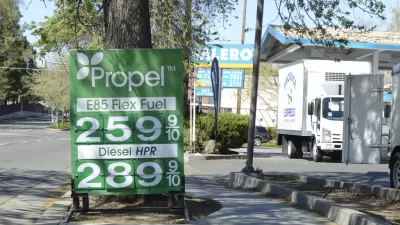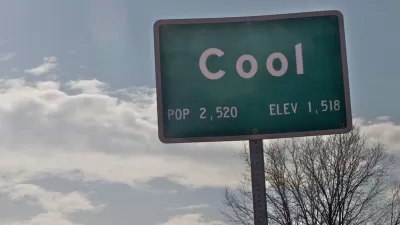Two market-based programs add about a quarter to every gallon of fuel purchased in the Golden State, but don't expect to see the prices listed anywhere. Furthermore, costs to comply with the Low Carbon Fuel Standard are expected to increase.

Designed to cut greenhouse gas emissions from fuel, the LCFS "now adds 12 to 14 cents per gallon to the cost of gasoline sold in the state, according to an estimate from the Oil Price Information Service (OPIS)," writes , clean energy reporter for the San Francisco Chronicle. "A recent report from the California Air Resources Board suggested that the tradeable credits will become increasingly scarce."
The fuel standard works by setting targets for reducing a fuel’s “carbon intensity” — a measure of the greenhouse gas emissions associated with producing and using it [e.g., lifecycle costs.]. The carbon intensity target gets incrementally tougher year by year, lowering emissions in the process.
Oil companies can comply by blending more biofuels into their products, particularly advanced biofuels such as renewable diesel and cellulosic ethanol. Or they can buy credits from companies that sell fuels with lower carbon intensities than the target.
Note that the additional costs to comply with the two credit-based programs are not included in the prices that total $3.51 for a gallon of gasoline in California in the Chronicle's gas can image. The LCFS is included in refinery costs. Motor vehicle fuel became subject to cap-and-trade on Jan. 1, 2015, and is included in both refinery and distribution costs.
Escalating costs of compliance
"For years, the program had little effect on California’s gasoline prices, adding perhaps 4 cents per gallon," adds Baker. But credit prices have more than doubled since last year, going from $76 to $173, with the added price to fuel tripling to 12 cents per gallon, and likely to go higher, although credits are capped at $200.
The state’s cap-and-trade system, in which companies throughout the economy pay for each ton of greenhouse gases they emit, tacks on an additional 12 to 13 cents, according to OPIS.
Immune from Trump administration rollbacks
With California's Advanced Clean Cars program under attack by the proposed SAFE Rule on Aug. 2, the LCFS could take on added importance. "[S]tate officials consider it one of their most important weapons to fight climate change," notes Baker.
In their announcement last month that the state had reduced greenhouse gas emissions to 1990 levels in 2016, four years ahead of schedule, CARB quantified the amount of greenhouse gas emissions reductions attributed to the program.
The transportation sector, the state’s largest source of greenhouse gases, saw a 2 percent increase in emissions in 2016 because of increased fuel consumption. But the state also saw cars and trucks use a record amount of biofuels – 1.5 billion gallons in all – as a result of the state’s Low Carbon Fuel Standard. These low-carbon alternative fuels, consisting mostly of biodiesel, renewable diesel, and ethanol, avoided 14 million metric tons of carbon dioxide from entering the atmosphere, compared to what would have happened if conventional fossil fuels had been used.
"Simon Mui, a senior scientist with the Natural Resources Defense Council, an environmental group, also credited the program to significant greenhouse gas emissions reductions from the transportation sector. "He called the fuel standard one of the state’s most effective climate policies, cutting an estimated 35 million metric tons of emissions so far," adds Baker.
“Certainly with the federal government attacking clean vehicle policies, California’s other programs will become even more critical,” he said.
Baker also observes that the cost of the LCFS now slightly exceeds the added gas tax that took effect Nov. 1, 2017, which voters will decide on Nov. 6 whether to repeal to reduce gas prices or retain to fund road repair and maintenance.
Hat tip to Chris Gilbert.
FULL STORY: California drivers pay growing cost for climate program

Study: Maui’s Plan to Convert Vacation Rentals to Long-Term Housing Could Cause Nearly $1 Billion Economic Loss
The plan would reduce visitor accommodation by 25,% resulting in 1,900 jobs lost.

Alabama: Trump Terminates Settlements for Black Communities Harmed By Raw Sewage
Trump deemed the landmark civil rights agreement “illegal DEI and environmental justice policy.”

Why Should We Subsidize Public Transportation?
Many public transit agencies face financial stress due to rising costs, declining fare revenue, and declining subsidies. Transit advocates must provide a strong business case for increasing public transit funding.

Paris Bike Boom Leads to Steep Drop in Air Pollution
The French city’s air quality has improved dramatically in the past 20 years, coinciding with a growth in cycling.

Why Housing Costs More to Build in California Than in Texas
Hard costs like labor and materials combined with ‘soft’ costs such as permitting make building in the San Francisco Bay Area almost three times as costly as in Texas cities.

San Diego County Sees a Rise in Urban Coyotes
San Diego County experiences a rise in urban coyotes, as sightings become prevalent throughout its urban neighbourhoods and surrounding areas.
Urban Design for Planners 1: Software Tools
This six-course series explores essential urban design concepts using open source software and equips planners with the tools they need to participate fully in the urban design process.
Planning for Universal Design
Learn the tools for implementing Universal Design in planning regulations.
Smith Gee Studio
Alamo Area Metropolitan Planning Organization
City of Santa Clarita
Institute for Housing and Urban Development Studies (IHS)
City of Grandview
Harvard GSD Executive Education
Toledo-Lucas County Plan Commissions
Salt Lake City
NYU Wagner Graduate School of Public Service




























